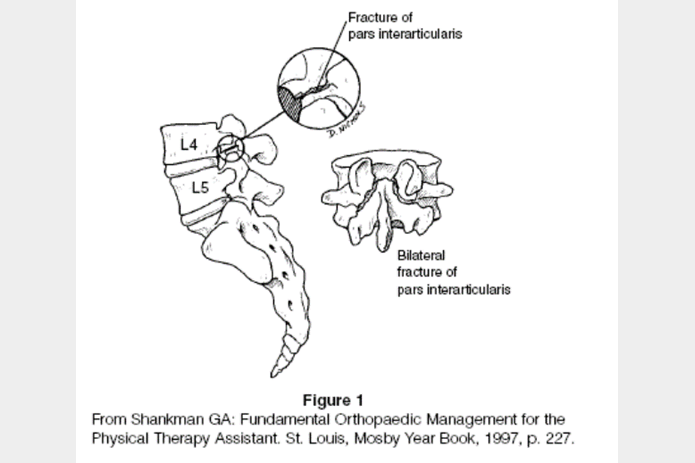Low Back Pain: Could it be a Spondylolysis?
Low back pain is the most common musculoskeletal complaint worldwide, with up to 85 percent of all people experiencing LBP during their lifetimes. Unfortunately, the most common complaint of low back pain in adolescents is more than a muscle strain: It’s a fracture.
Spondylolysis is a stress/overuse fracture of the bones in the spine, called vertebrae. It is caused by repetitive twisting and extension (arching) of the back and is the most common diagnosis for adolescent athletes experiencing low back pain.
It most often occurs in individuals who participate in sports such as baseball, gymnastics, dance/cheer, volleyball, football and soccer, but can be seen in any sport, including musical performance activities. While rarely, spondylolysis can be due to a sudden traumatic force such as an acute blow or fall, but most commonly presents as pain that develops during an activity.
Risk for spondylolysis may be associated with a family history of the condition. In rare cases, if a stress fracture occurs on both sides of the vertebra, it may shift or slip with respect to the vertebra below it. This is called a spondylolisthesis. Spondylolisthesis is much less common than spondylolysis.
What Are the Symptoms of Spondylolysis?
As spondylolysis commonly develops without injury, while playing a sport, pay attention to low back pain lasting longer than 2-3 weeks, especially if it worsens with arching the back (extension) and/or twisting. The pain may be central or on one side of the low back and is most commonly at the bottom levels of the spine.
Athletes may experience muscle spasm or stiffness in their low back in addition to their low back pain but should not have true weakness or numbness into the legs.

How Is Spondylolysis Treated?
It is important to consult a physician if your athlete experiences persistent low back pain. Imaging, such as X-rays or an MRI, is typically necessary to evaluate the injury.
- Initial treatment starts with helping the athlete lessen their pain, commonly with a combination of relative rest from the sport or activity that started the pain, and possibly a soft back brace to support the back in extension.
- If this does not improve the athlete’s pain, over the counter pain medications (Tylenol) may be considered. The goal for treatment of a spondylolysis is resolution of pain and return to all desired activities without pain and with full function and performance.
Physical therapy may be considered once pain resolves in the spine or immediately upon diagnosis of a spondylolysis. Physical therapists at Nationwide Children’s Hospital are trained in an innovative protocol that protects the spine until pain resolves and then moves progressively into spine motion and ultimately back to sport/activity once certain criteria are met. Average time to return to sport with this protocol is approximately 2.5 months, but recovery may take longer depending upon the severity of the injury and the sport.
Surgery is very rarely needed and is reserved for those athletes with persistent pain despite 6-12 months of appropriate conservative treatment.
How Can You Prevent Spondylolysis?
Developing and maintaining appropriate strength, posture, and control of the spine may help reduce the risk of sustaining a spondylolysis by optimizing the alignment of forces across the spine while performing in a sport or activity.
To avoid overuse injury, athletes should:
- Not participate in too much of any certain sport
- Have one rest day per week
- Get adequate sleep (8-9 hours per night)
- Have good nutrition that meets the needs of their sport, as well as their growth and development
Bone stress injuries are particularly common in athletes with poor nutrition. Low fuel availability (not enough calories in the diet) and low levels of certain vitamins (particularly calcium and vitamin D) can both increase the risk of bone stress injury.
Consult your primary care physician for more serious injuries that do not respond to basic first aid. As an added resource, the staff at Nationwide Children’s Hospital Sports Medicine is available to diagnose and treat sports-related injuries for youth or adolescent athletes. Services are available in multiple locations. To make an appointment, call (614) 355-6000 or schedule an appointment online.
Medical Reviewer: Anastasia N. Fischer, MD, Nationwide Children's Hospital
Date Last Reviewed: 12/8/2025
Sources & Publications:
- Selhorst M, MacDonald J, Martin LC, Rodenberg R, Krishnamurthy R, Ravindran R, Fischer A. Immediate functional progression program in adolescent athletes with a spondylolysis. Phys Ther Sport. 2021 Nov; 52: 140-146.
- Selhorst M, Rodenberg R, Padgett N, Fischer A, Ravindran R, MacDonald J. An Alternative Model of Care for the Treatment of Adolescent Athletes with Extension-Based Low Back Pain: A Pilot Study. Int J Sports Phys Ther. 2021 Feb 1; 16: 227-235.
The information provided here is only for general reference and should not take the place of medical care or patient education. If you have any questions, please call your child's care team.
